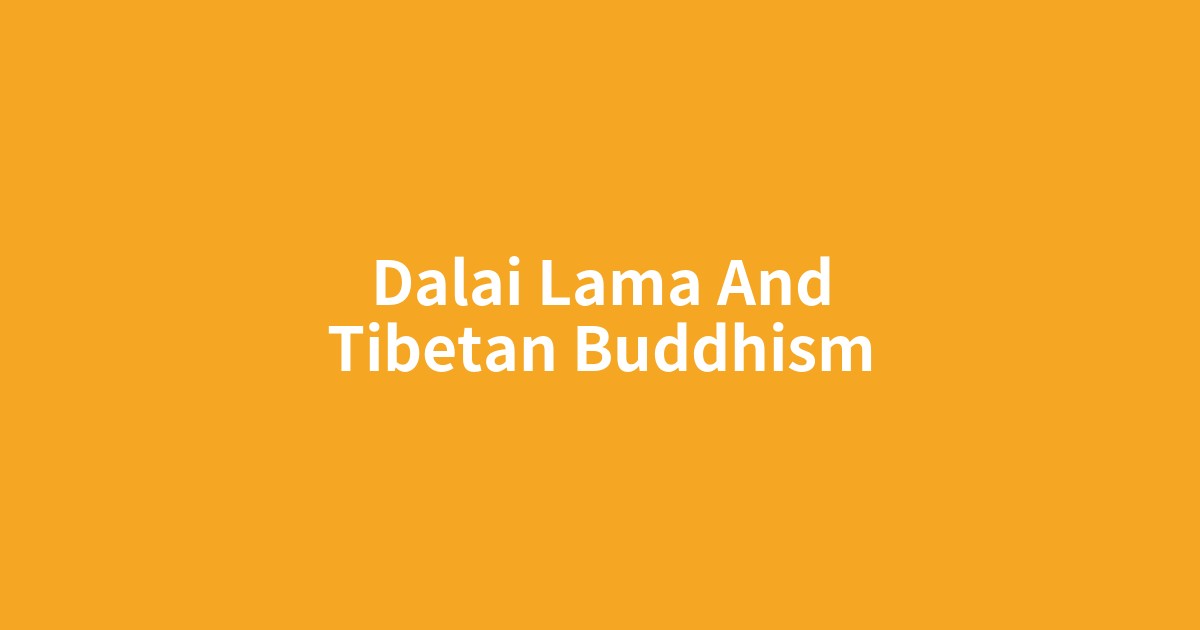このページは、歴史や文化の物語を楽しみながら、その文脈の中で重要な英単語を自然に学ぶための学習コンテンツです。各セクションの下にあるボタンで、いつでも日本語と英語を切り替えることができます。背景知識を日本語で学んだ後、英語の本文を読むことで、より深い理解と語彙力の向上を目指します。

観音菩薩の化身として、チベット仏教の最高指導者とされるダライ・ラマ。そのreincarnation(転生)の制度と、政治的・宗教的な役割の歴史。
この記事で抑えるべきポイント
- ✓ダライ・ラマが単なる宗教指導者ではなく、観音菩薩の「化身(incarnation)」とされ、チベット仏教ゲルク派の最高権威であるという基本概念。
- ✓その地位が世襲ではなく、先代の生まれ変わりを探し出す「転生(reincarnation)」という、世界でも類を見ない独特の継承制度によって受け継がれてきた歴史。
- ✓17世紀から20世紀半ばまで、ダライ・ラマがチベットの政治的元首でもあった「政教一致(theocracy)」体制と、その統治がチベット社会に与えた影響。
- ✓1959年のインドへの「亡命(exile)」以降、政治的役割から離れ、非暴力と慈悲を説く世界的な「精神的指導者(spiritual leader)」へと役割を変化させていった現代史。
ダライ・ラマとチベット仏教の歴史
多くの人が耳にしたことのある「ダライ・ラマ」。しかし、その称号がモンゴル語で「智慧の海」を意味することや、彼がどのように選ばれるのかを知る人は少ないかもしれません。この存在は、単なる高僧ではなく、チベットの人々にとっては観音菩薩の化身とされています。本記事では、この神秘的な指導者の起源と、チベットの歴史を動かしてきたその役割の変遷を、キーワード「reincarnation(転生)」を手がかりに紐解いていきます。
The Dalai Lama and the History of Tibetan Buddhism
Many people have heard the name "Dalai Lama." However, few may know that the title means "Ocean of Wisdom" in Mongolian, or how he is chosen. This figure is not merely a high priest but is considered an incarnation of Avalokiteshvara, the bodhisattva of compassion, by the Tibetan people. This article will unravel the origins of this mystical leader and the evolution of his role in shaping Tibetan history, using the keyword "reincarnation" as our guide.
智慧の海の誕生:ダライ・ラマ制度の始まり
ダライ・ラマが「観音菩薩の化身(incarnation)」とされる信仰は、チベット「仏教(Buddhism)」の深い伝統に根差しています。その称号が歴史の表舞台に現れたのは16世紀のことでした。チベット仏教ゲルク派の高僧であったソナム・ギャツォは、当時強力な軍事力を誇ったモンゴルのアルタン・ハーンと会見し、彼に仏法を説きました。これに深く感銘を受けたハーンは、ソナム・ギャツォに「ダライ・ラマ」という称号を贈呈します。これは彼の師と先師にも追贈され、ソナム・ギャツォは3世となりました。この出来事は、単なる称号の授与に留まらず、モンゴルの軍事力を後ろ盾に、ゲルク派がチベットにおける宗教的「権威(authority)」を確立する上で決定的な一歩となったのです。
The Birth of the Ocean of Wisdom: The Origin of the Dalai Lama System
The belief that the Dalai Lama is an "incarnation" of Avalokiteshvara is deeply rooted in the rich tradition of Tibetan "Buddhism." The title first appeared on the stage of history in the 16th century. Sonam Gyatso, a high lama of the Gelug school of Tibetan Buddhism, met with Altan Khan of Mongolia, who wielded formidable military power at the time, and preached the Dharma to him. Deeply impressed, the Khan bestowed the title "Dalai Lama" upon Sonam Gyatso. This title was also posthumously given to his predecessors, making Sonam Gyatso the third. This event was more than a mere conferral of a title; with the backing of Mongolian military power, it was a decisive step in establishing the religious "authority" of the Gelug school in Tibet.
ポタラ宮の主:政教一致体制の確立
ダライ・ラマの役割が宗教的な領域を超え、政治の頂点に立ったのは17世紀、ダライ・ラマ5世の時代です。彼は「偉大なる5世」と称され、巧みな政治手腕とモンゴルからの支援を背景に、チベット全土を初めて統一しました。これにより、ダライ・ラマを元首とする政府が成立し、宗教指導者が国家の最高権力者でもある「神権政治(theocracy)」、すなわち政教一致体制が確立されたのです。その絶大な権力の象徴として、今日チベットのランドマークとして知られる壮麗なポタラ宮の建設が始まりました。以後、20世紀半ばに至るまで、ダライ・ラマはチベットの政治と宗教の両面における絶対的な指導者として君臨し続けました。
Master of the Potala Palace: The Establishment of a Theocracy
The role of the Dalai Lama transcended the religious sphere to reach the pinnacle of political power in the 17th century, during the time of the 5th Dalai Lama. Known as "the Great Fifth," he unified all of Tibet for the first time through skillful politics and support from Mongolia. This led to the establishment of a government with the Dalai Lama as its head, creating a system of "theocracy" where the religious leader is also the supreme ruler of the state. As a symbol of this immense power, construction began on the magnificent Potala Palace, known today as a landmark of Tibet. From then until the mid-20th century, the Dalai Lama reigned as the absolute leader in both the political and religious life of Tibet.
魂の継承者を探して:神秘的な転生者認定プロセス
ダライ・ラマの地位は世襲ではなく、先代の生まれ変わりを探し出すという、世界でも類を見ない方法で受け継がれます。この「転生(reincarnation)」者を探すプロセスは、極めて神秘的かつ厳格な儀式に則って行われます。先代の遺言や高僧が見る神託、聖なる湖に映る映像などを手がかりに候補地が絞り込まれ、複数の候補者の少年の中から、先代の遺品を正確に見分ける試験などを通じて真の転生者が認定されます。この独特な「継承(succession)」制度は、チベット仏教の信仰の核心をなすものですが、時に後継者認定を巡って教団内や周辺国との間で政治的な緊張を生む要因ともなってきました。
The Search for the Soul's Successor: The Mystical Reincarnation Process
The position of the Dalai Lama is not hereditary. Instead, it is passed down through a unique method of searching for the reincarnation of the predecessor. This process of identifying the "reincarnation" is conducted according to extremely mystical and rigorous rituals. Clues such as the previous Dalai Lama's will, prophecies from high lamas, and visions appearing in a sacred lake are used to narrow down potential locations. From a group of candidate boys, the true successor is identified through tests, such as correctly selecting the personal belongings of the predecessor. While this distinctive "succession" system is central to the faith of Tibetan Buddhism, it has at times been a source of political tension within the religious order and with neighboring countries over the recognition of a successor.
亡命、そして世界的指導者へ:ダライ・ラマ14世の道
20世紀に入り、世界の情勢が大きく動く中で、ダライ・ラマの役割もまた大きな転換点を迎えます。1959年、中国によるチベット支配の強化を背景に、現ダライ・ラマ14世はインドへの「亡命(exile)」を余儀なくされました。これは、彼の人生だけでなくチベットの現代史における決定的な出来事です。インドでチベット亡命政府を樹立した彼は、当初チベットの「主権(sovereignty)」回復を目指していましたが、次第にその活動の軸足を移していきます。2011年には政治的権限を完全に手放し、以後は純粋に世界平和や非暴力を説く「精神的指導者(spiritual leader)」としての役割に専念しています。彼の教えの根幹には、常に他者への「慈悲(compassion)」の心があります。
Exile and the Path to a Global Leader: The Journey of the 14th Dalai Lama
As global dynamics shifted dramatically in the 20th century, the role of the Dalai Lama also faced a major turning point. In 1959, amid increasing Chinese control over Tibet, the current 14th Dalai Lama was forced into "exile" in India. This was a defining moment not only in his life but in modern Tibetan history. After establishing the Tibetan Government-in-Exile in India, he initially aimed to restore Tibet's "sovereignty" but gradually shifted the focus of his activities. In 2011, he completely relinquished his political authority and has since dedicated himself purely to the role of a "spiritual leader," advocating for world peace and non-violence. At the core of his teachings is always a heart of "compassion" for others.
結論:時代を超えて響く慈悲のメッセージ
ダライ・ラマの歴史は、チベットの宗教、文化、そして政治の歴史そのものです。「転生(reincarnation)」という信仰に根ざしながらも、その役割は時代の要請と共に、宗教的権威から政治的元首へ、そして現代においては国境を超えた「精神的(spiritual)」な指導者へと大きく変化してきました。政治的な権力から離れた今、彼が発する「慈悲(compassion)」のメッセージは、なぜこれほどまでに宗教や文化の壁を超えて世界中の人々の心を動かすのでしょうか。その答えは、あらゆる生命への深い思いやりという、人類にとって普遍的な価値観の中にこそ見出せるのかもしれません。
Conclusion: A Message of Compassion that Resonates Through the Ages
The history of the Dalai Lama is the history of Tibetan religion, culture, and politics itself. While rooted in the belief of "reincarnation," his role has evolved significantly with the demands of the times—from a religious authority to a political head of state, and in the modern era, to a transnational "spiritual" guide. Now that he is detached from political power, why does his message of "compassion" move the hearts of people across the globe, transcending religious and cultural barriers? The answer may lie in a universal value for humanity: a deep sense of care for all living beings.
テーマを理解する重要単語
authority
「権威」や「権力」を意味します。この記事では、ダライ・ラマがモンゴルの支援を得て宗教的「権威」を確立し、やがてチベット全土を治める政治的「権力」をも手にする過程が描かれています。宗教と政治における影響力の変遷を読み解く上で、この単語のニュアンスの理解が鍵となります。
文脈での用例:
The professor is a leading authority on ancient history.
その教授は古代史に関する第一人者(権威)だ。
spiritual
「精神的な」または「霊的な」という意味の形容詞です。この記事では、ダライ・ラマの役割が政治的なものから「精神的」な指導者へと変化したことを示しています。物質的な世界や政治権力とは一線を画した、内面的な価値や宗教的・哲学的領域を指す言葉として、現代における彼の存在意義を理解する上で欠かせません。
文脈での用例:
Yoga is a form of exercise that benefits both physical and spiritual well-being.
ヨガは、身体的および精神的な健康の両方に利益をもたらす運動の一形態です。
compassion
「慈悲」や「他者への深い思いやり」を意味します。ダライ・ラマ14世の教えの根幹をなす概念であり、記事の結論部分でも強調されています。彼のメッセージが、なぜ宗教や文化の壁を超えて世界中の人々の心を動かすのか、その理由を解き明かす鍵となる、人間性の中核に触れる単語です。
文脈での用例:
The nurse showed great compassion for her patients.
その看護師は患者に対して深い思いやりを示した。
exile
名詞で「亡命」、動詞で「追放する」という意味を持ちます。1959年に現ダライ・ラマ14世がインドへ「亡命」したことは、チベット現代史における決定的な出来事です。彼の人生と役割が大きく転換するきっかけとなったこの歴史的背景を理解し、その後の活動の文脈を掴むために必須の単語です。
文脈での用例:
After his defeat, the former leader was forced into exile.
敗北後、その元指導者は亡命を余儀なくされた。
Buddhism
「仏教」を指します。この記事のテーマであるチベット仏教の歴史を理解するための基礎となる単語です。ダライ・ラマの信仰や制度が、より大きな「仏教」という伝統の中にどのように位置づけられているのかを把握することで、物語全体の背景知識が深まり、より立体的な読解が可能になります。
文脈での用例:
Buddhism originated in India and later spread to other parts of Asia.
仏教はインドで発祥し、後にアジアの他の地域に広まりました。
hereditary
「世襲の」または「遺伝的な」という意味です。この記事では「ダライ・ラマの地位は世襲ではない(not hereditary)」と、その継承方法の特異性を強調するために使われています。一般的な王位継承などとの違いを明確にすることで、転生者を探すというチベット仏教ならではの制度の独自性が際立ちます。
文脈での用例:
In a hereditary monarchy, the crown is passed down within the same family.
世襲君主制では、王位は同じ家系内で受け継がれます。
transcend
「~を超える、超越する」という意味の動詞です。ダライ・ラマの役割が宗教の領域を超えて政治の頂点に立ったことや、彼の慈悲のメッセージが文化の壁を超えて世界に広がる様子を表すのに使われます。物事がある制約や境界を乗り越えていくダイナミックな変化を表現するのに適した単語です。
文脈での用例:
The beauty of the music seems to transcend cultural differences.
その音楽の美しさは文化の違いを超えるようだ。
resonate
「共鳴する、心に響く」という意味の動詞です。記事の結びで、ダライ・ラマのメッセージが「時代を超えて響く」と表現されています。ある考えや感情が、他者の心に深く届き、共感を呼ぶ様子を示す言葉です。彼の教えが持つ普遍的な力を理解する上で、この単語のニュアンスは非常に効果的です。
文脈での用例:
His speech resonated with the audience.
彼のスピーチは聴衆の心に響いた。
sovereignty
国家が他国からの干渉を受けずに自国のことを決定できる権利、すなわち「主権」を意味します。ダライ・ラマ14世が亡命当初に目指した「チベットの主権回復」という政治目標を理解するために不可欠な言葉です。彼の活動が政治的なものから精神的なものへと移行した変遷を捉える上で重要です。
文脈での用例:
The nation fought to defend its sovereignty against foreign invasion.
その国は外国の侵略から自国の主権を守るために戦った。
succession
「継承」を意味する単語で、特に地位や役職が次の代に受け継がれる文脈で使われます。この記事では、世襲ではないダライ・ラマの独特な後継者選びのプロセスを指しています。この制度がチベット仏教の信仰の核心であると同時に、時に政治的緊張を生む要因となる点を理解するのに役立ちます。
文脈での用例:
The death of the king led to a crisis of succession.
王の死は、後継者問題の危機を引き起こした。
reincarnation
この記事全体の鍵となる単語です。「転生」を意味し、ダライ・ラマの地位が世襲ではなく、先代の魂の生まれ変わりを探すことで継承されるというチベット仏教の核心的信仰を指します。この独特な制度が、チベットの歴史や政治にどう影響を与えてきたかを理解するために不可欠な概念です。
文脈での用例:
The concept of reincarnation is central to many Eastern religions, including Hinduism and Buddhism.
輪廻転生という概念は、ヒンドゥー教や仏教を含む多くの東洋宗教の中心です。
theocracy
「神権政治」と訳され、宗教指導者が国家の最高統治者となる政治体制を指します。ダライ・ラマ5世がチベットを統一し、自らを元首とする政府を樹立した体制を的確に表現する言葉です。この専門用語を知ることで、17世紀以降のチベットがどのような国家だったのかを明確に理解できます。
文脈での用例:
In a theocracy, religious leaders hold the ultimate authority.
神権政治においては、宗教指導者が最終的な権威を握る。
incarnation
「化身」や「権化」を意味し、ダライ・ラマが単なる高僧ではなく「観音菩薩の化身」と信じられていることを示す重要単語です。reincarnation(転生)と合わせて理解することで、彼の存在が持つ宗教的な神聖性や、チベットの人々にとっての特別な意味合いを深く把握することができます。
文脈での用例:
In the story, the hero is the incarnation of justice.
その物語の中で、主人公は正義の化身です。
spiritual leader
「精神的指導者」を意味するフレーズです。政治的権限を手放した現在のダライ・ラマ14世の役割を的確に表しています。彼が特定の国家や民族の指導者にとどまらず、世界平和や非暴力を説く普遍的な存在へと変化したことを理解する上で、この言葉は非常に重要な意味を持っています。
文脈での用例:
Martin Luther King Jr. was a great spiritual leader of the Civil Rights Movement.
マーティン・ルーサー・キング・ジュニアは、公民権運動の偉大な精神的指導者でした。